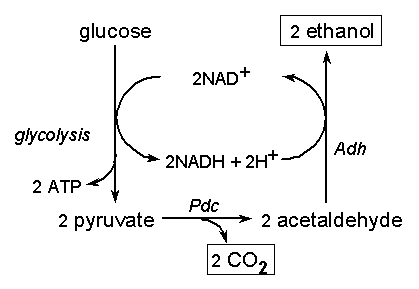| Home | Team | Project | Parts | Outreach | Protocols | Notebook | Attributions | Links |
|---|
Welcome to Dartmouth iGEM!!
Abstract
Pyruvate decarboxylase (PDC) and alcohol dehydrogenase 2 (ADH2) are key enzymes for mediating ethanol production from pyruvate. A particularly well-characterized PDC-ADH system has been found in Zymomonas mobilis, and this pathway has been used to engineer a variety of bacteria for ethanol production. In some cases, this pathway works well, resulting in high levels of ethanol production. In other cases, however, the pathway does not work very well. To understand this, we aim to develop a set of BioBrick compatible expression vectors with different plasmid replicons to allow expression of the PDC-ADH pathway in a range of different bacteria. Organisms expressing the PDC-ADH pathway will be assayed for PDC and ADH activity by enzyme assay and for ethanol production by high-pressure liquid chromatography (HPLC). These new expression plasmids will be useful for other groups looking to expand their BioBrick engineering beyond the confines of current model or "chassis” organisms.
Project Description
With increasing attention on the development of biofuels, it is imperative to develop more efficient means of ethanol production. Since the current method of ethanol production using yeast can be slow and expensive, we intend to maximize the amount of ethanol production using bacteria. Multiple species of bacteria will be tested for the amount of ethanol production following transformation using a well-characterized vector, pLOI297, that codes for PDC and ADH genes. Ethanol holds promise as an easily sources biofuel in light of recent advances in biochemical techniques and recombinant genetics. As a hallmark of reduced-carbon footprint biofuels, ethanol is already incorporated as a regulation percentage of most commercial fuels. Initially, ethanol was harvested as a byproduct of yeast catalyzed fermentation of corn. While yeast produces high conversion yields, ethanol synthesis based on corn lead to elevated prices in fuel, animal fodder, and human consumables. On the other hand, ethanol synthesis via bacteria replaces corn with other fuel sources, such as cellulose, the most abundant bio-material on the planet. While current techniques in bacteria mediated ethanol synthesis do not quite meet yeast-standards in terms of conversion yield, bacteria-based mechanisms have greater versatility in cultivation environments, potential for recombinant enhancement, and rate of ethanol conversion.
Figure 4. Reoxidation of NADH via the alcoholic fermentation pathway in Saccharomyces cerevisiae. Pdc, pyruvate decarboxylase; Adh, alcohol dyhdrogenase. https://marcelf.home.xs4all.nl/GeneralIntroduction.htm
Pyruvate decarboxylase (referred to as PDC) is a homotetrameric enzyme. In an anaerobic environment, the PDC enzyme catalyzes the decarboxylation of pyruvic acid to acetaldehyde and carbon dioxide. This is a critical step in the fermentation process for many organisms. As a result, research has been conducted into incorporating PDC from organisms such as Saccharomyces cerevisiae into other bacteria to improve their ethanol yields. These bacteria offer advantages over yeast organisms due to faster growth times, different food sources and growing environments. In addition, prokaryotic bacteria are easier to genetically modify than eukaryotic yeast.
The goal of this project is to screen a series of bacteria for compatibility with PDC gene integration, expression and increased ethanol production. The bacteria selected for screening come from a diverse range of environments and niche properties. These would allow for ethanol production from sources other than sugar produced from human consumable foodstuffs and allow for cheaper and less disruptive ethanol production. One bacteria, Ralstonia eutropha for example is able to process biodegradable plastics and will be a particularly interesting research topic. Another bacteria, Geobacillus stearothermophilus, is also particularly interesting in that it will thrive in extreme conditions, which would be ideal for projects requiring sterile environments as the high growing temperatures would eliminate most contaminations.


